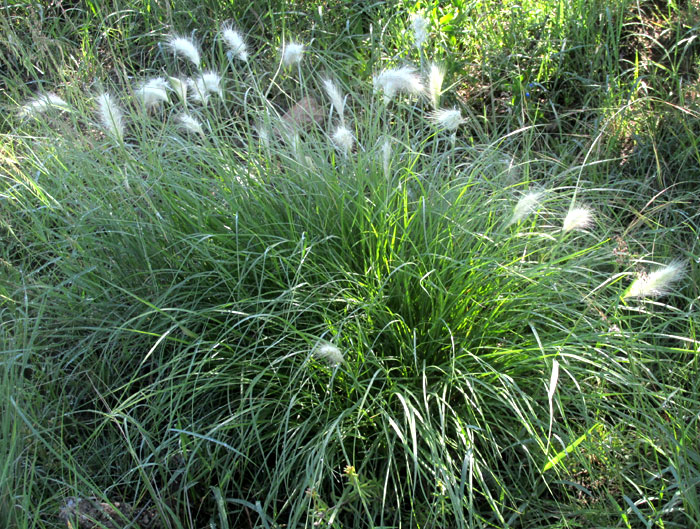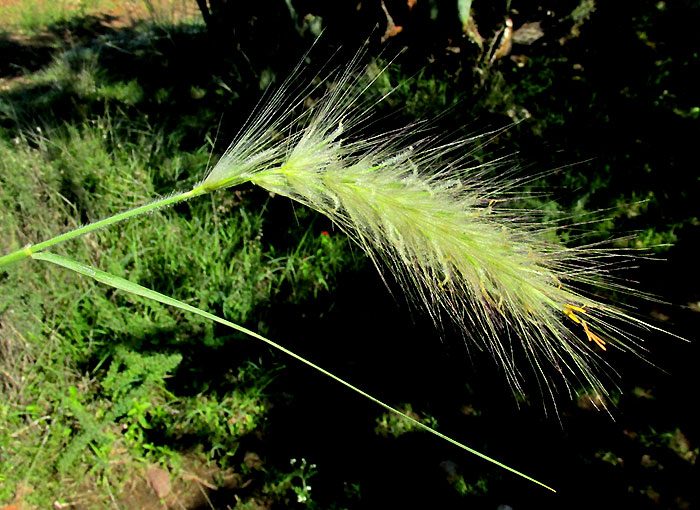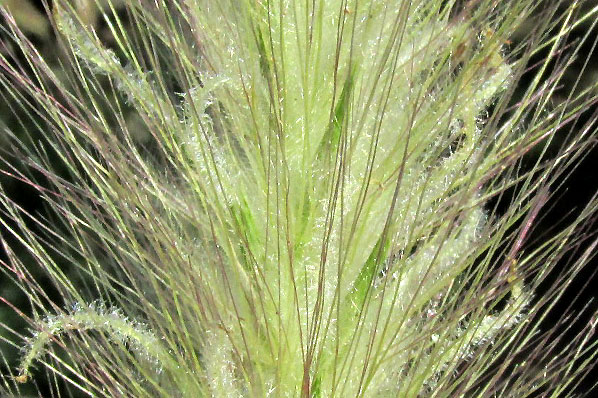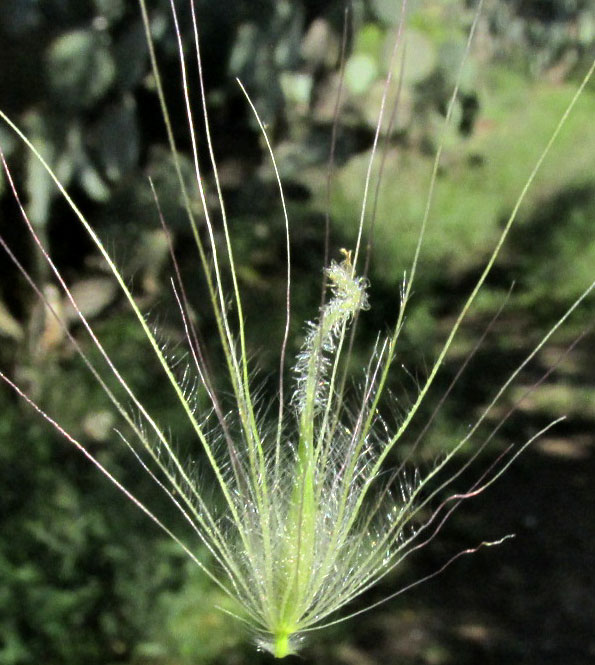Excerpts from Jim Conrad's
Naturalist Newsletter
entry dated September 11, 2022, issued from near Tequisquiapan, elevation about 1,900m (6200 ft), N20.565°, W99.890°, Querétaro state, MÉXICO
FEATHERGRASS

In a fenced-in area mostly vegetated with young mesquites and clumpgrass, sometimes things turn up not found in surrounding pastures because livestock haven't been introduced for some years. Probably it's an absentee landowner who has lost interest. Above, in the shade of a mesquite, is an eye-catching grass, the only individual of the species I've seen here.

It's the inflorescence that captures attention, so white and fuzzy that it seems to glow from an inner light. In the above picture, florets are in full flower, with pencil-shaped, yellow male anthers dangling from at the inflorescence's top, florets, and long, fuzzy styles emerging from florets lower down. The styles, which are are the ovary's "neck" and in this case are fused with the stigmas, are long and fuzzy, the better to collect pollen. Here's a closer look:

And here's a single spikelet removed from the inflorescence.

In the above picture, despite each spikelet housing two florets, only one fuzzy style is seen because the lower floret is sterile, bearing stamens but no ovary. We can't see this detail in the above picture, but with good magnification and a dissection needle people have figure it out.

With grass identification usually knowing details about the inflorescence, spikelets and florets is enough to figure out the species, but often it's still a good idea to notice the ligule, pictured above. Ligules are outgrowths of a leaf's sheath, which wraps around the stem where the leaf encounters the stem. The ID value of ligules is that they take many forms, but their forms are constant within the species. Our grass's ligules consists of a dense line of very slender, short hairs where the blade meets the stem, plus both sides of the ligule long hairs sprout along the lower blade and, opposite the blade, the rim of the split in the sheath. I read that in this species the longer extra-ligule hairs sometimes don't exist.
In our area, if you have a grass whose spikelets are arranged in panicle-type inflorescences (divided into divisions that may be divided more and more), in which individual spikelets are subtended by long, stiff hairs, and when the spikelet comes off the hairs accompany it below, you have the taxon Pennisetum. And if the spikelets of your Pennisetum are hidden among such long, stiff hairs, you have CENCHRUS LONGISETUS, formerly known as Pennisetum villosum, in English often called Feathertop.
Feathertop is native to Ethiopia, northern Somalia and the Arabian Peninsula, but has spread into warm regions worldwide as an invasive. Sometimes it's planted as an ornamental, and escapes, particularly in the warm parts of the US, Australia, South Africa, southern Europe and here in Mexico. The Malezas de México website (Mexican Weeds) describes the species as en expansión here. Since I've seen no other Feathertop plants in Mexico, it seems that our individual is a pioneer in this area, and who knows how it got here? The Mexican Weeds page describe it as an ornamental. Websites dealing with forage plants describe it as having little or no forage value, probably because of the long, stiff hairs, so probably it wasn't sown in a grass mixture.
Two binomials, Pennisetum villosum and Cenchrus longisetus, are provided above because the taxonomy of this plant currently is a mess. At this writing, of the two main authorities on whether a binomial is up to date, Kew Garden's Plants of the World Online accepts Cenchrus longisetus and refers to Pennisetum villosum as a synonym of Cenchrus longiseteus. However, the World Flora Online accepts both Pennisetum villosum and Cenchrus longisetus.
However, on the Internet at this writing, most authorities appear to be sticking with the old name of Pennisetum villosum, and it doesn't seem that it's only because of the time it takes to update web pages.
Maybe part of the story is that in botanist's minds the inflorescences of Pennisetum species like our Feathertop are cute and fuzzy, while the spikelets of Cenchrus species, the bur-grasses, bear short, very hard, woody spines that are murderous to step on barefooted, and tear up the mouths of unwary livestock.
The confusion began in 2009 when Sabina Donadío and others found, based on gene studies, that the sharp-spined Cenchrus is "nested" within the fluffy genus Pennisetum. Of course, in Nature if a real tree's branch is visualized as one thing, then all branchlets within that branch must belong to the bigger one thing. A year later, in 2010, M. Amelia Chemisquy and others, in a long-titled study beginning with "Phylogenetic studies favour the unification of Pennisetum, Cenchrus and Odontelytum (Poaceae)...," noting that the name Cenchrus originally was published before the name Pennisetum, the feathery Pennisetum species were merged into the bloodletting genus Cenchrus.
Many don't seem to be going along with the change. At this time the Flora of North America ignores the change, as do Wikipedia contributors, and the main Mexican pages. Jan-Frits Veldkamp in his 2014 revision of Malesian species does use the new Cenchrus name but sniffs that Chemisquy and others are "... apparently more induced by the molecular 'evidence' (Veldkamp's quotes) than the nomenclatural stability of the majority of the species." In botany, publishing a word like "evidence" within quotes, in reference to someone else's work, is like shooting off a cannon.
Anyway, two binomials, take your pick. In a world where false news elects presidents and quantum physics shows that one thing can be in two places at once, an organism with two human-imagined binomials is no problem.